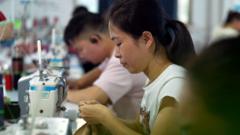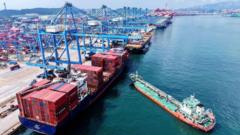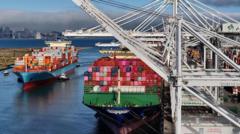An investigation exposes the working conditions in Guangzhou's factories that produce affordable clothing for a global market.
**Behind the Price Tag: The Human Cost of Fast Fashion's Success**

**Behind the Price Tag: The Human Cost of Fast Fashion's Success**
The hidden workforce powering Shein reveals crucial insights into fast fashion's impact on labor conditions.
In the vibrant industrial heart of Guangzhou, southern China, a cacophony of sewing machines fills the air, echoing the relentless production of affordable garments intended for fashion-hungry consumers worldwide. The neighborhood, known as "Shein village," serves as a critical hub supporting the rapid rise of Shein, once a small online player that has burgeoned into the world's leading fast fashion retailer. With products available at astonishingly low prices—like £12 dresses and under £8 sweaters—the cost may lie not just in the fabric but heavily on the labor that produces them.
Recent reports from the BBC detail the often grueling working conditions faced by factory employees in Panyu, underscoring a troubling reality of labor practices. Workers endure upwards of 75 hours a week, often with only one day off per month, considerably exceeding China's legal limits. Learning from interviews conducted with both workers and factory owners, it is clear that the quest for economic opportunity has led many rural migrants to endure these excessive hours and exploitative wages in hopes of supporting their families back home.
The success of Shein—valued at approximately £54bn ($66bn) in 2023—has not come without significant scrutiny regarding labor rights. Past allegations include the presence of child workers within its supply chain. In response, the company asserts a commitment to ethical practices and robust monitoring of its operations. However, many workers receive meager compensation, with payments based on a piece-rate system—around one to two yuan, or less than a dollar, per basic item produced.
As awareness grows, there is mounting pressure from rights groups and even political figures in the West scrutinizing Shein's operations. Accusations of "slave labor" and unethical sourcing, particularly in relation to cotton from Xinjiang—a region fraught with human rights issues—cast a long shadow over the company's rise to fame. Experts suggest that achieving a public listing on the London Stock Exchange hinges on rectifying these reputational challenges, pushing for transparency in its supply chain to gain investor confidence.
Despite the struggles, many factory owners still praise Shein for timely payments and the steady flow of business that they generate. "Shein is a pillar of the fashion industry," one supplier testified, reflecting the duality of its existence. While workers often suffer, they also express pride in contributing to a global marketplace that reflects their labor.
As night falls over Guangzhou, the relentless hum of production continues, embodying the intricacies of a system that fuels fast fashion. Shoppers in cities around the world now hunt for their next bargain, often oblivious to the lives and labor ensconced behind the glossy facade of discount clothing. In this complex web of economics, ethics, and ambition, the journey of each inexpensive garment asks us to take a deeper look beneath the price tag.
Recent reports from the BBC detail the often grueling working conditions faced by factory employees in Panyu, underscoring a troubling reality of labor practices. Workers endure upwards of 75 hours a week, often with only one day off per month, considerably exceeding China's legal limits. Learning from interviews conducted with both workers and factory owners, it is clear that the quest for economic opportunity has led many rural migrants to endure these excessive hours and exploitative wages in hopes of supporting their families back home.
The success of Shein—valued at approximately £54bn ($66bn) in 2023—has not come without significant scrutiny regarding labor rights. Past allegations include the presence of child workers within its supply chain. In response, the company asserts a commitment to ethical practices and robust monitoring of its operations. However, many workers receive meager compensation, with payments based on a piece-rate system—around one to two yuan, or less than a dollar, per basic item produced.
As awareness grows, there is mounting pressure from rights groups and even political figures in the West scrutinizing Shein's operations. Accusations of "slave labor" and unethical sourcing, particularly in relation to cotton from Xinjiang—a region fraught with human rights issues—cast a long shadow over the company's rise to fame. Experts suggest that achieving a public listing on the London Stock Exchange hinges on rectifying these reputational challenges, pushing for transparency in its supply chain to gain investor confidence.
Despite the struggles, many factory owners still praise Shein for timely payments and the steady flow of business that they generate. "Shein is a pillar of the fashion industry," one supplier testified, reflecting the duality of its existence. While workers often suffer, they also express pride in contributing to a global marketplace that reflects their labor.
As night falls over Guangzhou, the relentless hum of production continues, embodying the intricacies of a system that fuels fast fashion. Shoppers in cities around the world now hunt for their next bargain, often oblivious to the lives and labor ensconced behind the glossy facade of discount clothing. In this complex web of economics, ethics, and ambition, the journey of each inexpensive garment asks us to take a deeper look beneath the price tag.

















